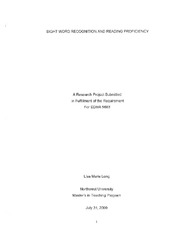| dc.contributor.author | Long, Lisa Marie | en |
| dc.date.accessioned | 2017-10-02T22:46:56Z | |
| dc.date.available | 2017-10-02T22:46:56Z | |
| dc.date.issued | 7/31/2009 | en |
| dc.identifier.uri | archives.northwestu.edu/handle/nu/25705 | |
| dc.description.abstract | There is a large body of research surrounding the importance of teaching sight words in the classroom as a key component of any reading program because of the relationship that exists between sight words recognition and reading proficiency. Students encounter many different unfamiliar words as they read daily in classrooms across the nation and they struggle to read proficiently. So, the question remains, is there a correlation between sight word recognition and reading proficiency? The following study took place in a Kindergarten classroom, aiming to gather data about students’ ability to read sight words and their original reading level compared to these two items many weeks later after targeted instruction. Although the data does not give enough information to make answer the research question, it does imply things and sheds light on some themes – these themes including sight word recognition and its relationship to fluency and comprehension as well as varying methods for teaching sight words. | en |
| dc.format.extent | iii, 32 pages | en |
| dc.format.medium | PDF | en |
| dc.language.iso | en | en |
| dc.publisher | Northwest University | en |
| dc.rights | This original work is protected by copyright. Copyright is retained by the author(s). Works may be viewed, downloaded, or printed, but not reproduced or distributed without author(s) permission. | en |
| dc.rights.uri | http://archives.northwestu.edu/page/copyright | en |
| dc.subject | English Lanugage Arts (ELA) | en |
| dc.title | Sight Word Recognition and Reading Proficiency | en |
| thesis.degree.name | Master in Teaching | en |
| thesis.degree.level | Masters | en |
| thesis.degree.grantor | Northwest University | en |
| thesis.degree.discipline | College of Education | en |


 Maintained by the Northwest University Library
Maintained by the Northwest University Library